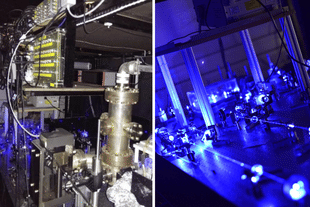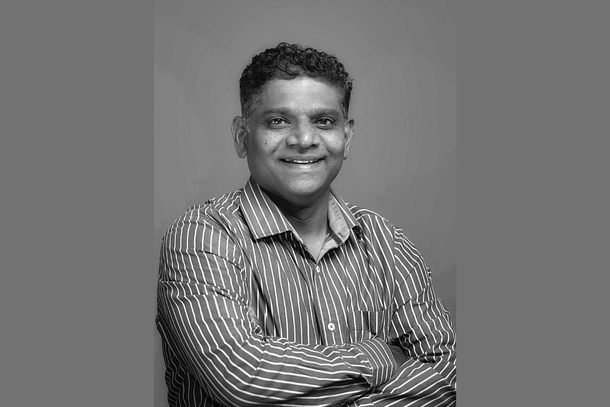Science
New Quantum Tech Hub At IISER Pune: Quantum Computers, Sensors, Clocks And More On The Cards
Karan Kamble
Apr 30, 2021, 09:59 PM | Updated 10:00 PM IST
Save & read from anywhere!
Bookmark stories for easy access on any device or the Swarajya app.


A new quantum technology hub, set up at the Indian Institute of Science Education and Research (IISER), Pune, with the support of the Department of Science and Technology (DST), promises to be a common area for many things quantum in India over the coming years.
Established as a Section-8 company, the I-Hub Quantum Technology Foundation (I-Hub QTF) aims to produce quantum computers, quantum communication devices and systems, and novel quantum materials and sensors, among other things.
IISER Pune director, Professor Jayant Udgaonkar has said that the hub will help the country in carrying out "cutting-edge research and development in a field... at the frontier of the new technologies that will revolutionize our way of living over the next few decades".
The idea behind this new quantum development engine is to get researchers in the field spread across the country working under one roof.
As Associate Professor Umakant D Rapol of IISER Pune explains, "(The hub) is for having better coordination between researchers and driving targeted research work and product development."
It will be a "distributed innovation hub", he says, as the nodal officer for the IISER Pune quantum technology hub.
India’s Quantum Leap
The government made its intentions clear on quantum technology development in India when, in Union Budget 2020, Finance Minister Nirmala Sitharaman announced the allocation of Rs 8,000 crore over a period of five years for setting up a National Mission on Quantum Technologies & Applications (NM-QTA).
Sitharaman had said at the time that "the new economy is based on innovations that disrupt established business models" and many commercial applications are expected to "emerge from theoretical constructs which are developing in this (quantum) area".
Though NM-QTA is yet to kick off, the quantum technology hub at IISER Pune has been formed under an earlier National Mission on Interdisciplinary Cyber Physical Systems (NM-ICPS).
This mission had received the Union Cabinet nod in December 2018 and sought to catch up to and work with frontier technologies. Its implementation strategy included establishing 15 Technology Innovation Hubs (TIHs), six Sectoral Application Hubs (SAHs), and four Technology Translation Research Parks (TTRPs) – 25 in all.
Later, the total number of hubs to be set up (not counting the TTRPs) was revised to 25. The IISER quantum technology hub is part of this plan.
“The quantum tech hub is an important development along with the various other programmes that have started in the last couple of years. These include funding programmes by DST, DRDO, MeiTY and others. All of these will help increase the breadth and scale of research in India,” says R Vijayaraghavan, Associate Professor at the Department of Condensed Matter Physics & Material Science, Tata Institute of Fundamental Research (TIFR).
He says that the hub will help particularly in linking academic research and industry, and lay the foundation for commercial quantum technologies in India.
Quantum technology is still an emerging field of physics and engineering, so the I-Hub QTF will be tailoring its approach to activities accordingly.
"Different quantum technologies are at different readiness levels," says Prof Rapol. "There are some areas that are technology-proven and which have to be developed and there are some that have to be proven still."
The implication is that quantum technologies at a more advanced stage of research and development will be translated into products while those in the nascent stages will be put through the wringer of scientific research before they can be shipped ahead on the conveyor belt of development.
An encouraging point to infer from this way of working with quantum technology is that the hub is designed to contain activities across the full spectrum from idea to product.
Research-and-development work at the hub will also encompass the more traditional areas and approaches so they can, in turn, enable quantum engineering solutions. This will include, for instance, work on new materials and electronics.
Development of radio frequency technology, optical systems, data control and acquisition systems are some examples that Prof Rapol highlights in this regard. "We have to synergise with other hubs whenever there is potential for joint development," he says.
Broadly, communication, cryptography, computing, metrology, sensing, and materials are the areas where quantum technology can make a difference, if not provide outright breakthroughs.
"Some of the things that can reach commercial application early are precise magnetic field sensors, atomic clocks, and atom interferometry sensors," Prof Rapol says.
Atom interferometry and atomic clocks are among the primary areas of research for the experimental atomic physics group led by Prof Rapol at IISER Pune.

According to Prof Vijayaraghavan, early commercial applications in quantum communication and quantum sensing are possible, but the wait may be relatively longer in the area of quantum computers and simulators.
“However,” he adds, “commercialisation of some component technologies is possible in the quantum computing space, which include ultra-low noise cryogenic amplifiers, high-speed control electronics, and microwave signal processing circuits”.
Prof Vijayaraghavan is the head of the Quantum Measurement and Control Laboratory at TIFR. He leads a group of researchers who have developed a unique three-qubit “trimon” quantum processor. He is simultaneously developing conventional seven-qubit systems as well.
I-Hub QTF: What To Expect
One of the early goals of the hub is to develop a quantum computer of 20-30 qubits.
This appears to be a step up from the level of qubits Indian researchers are currently working at – under 10 qubits. But the number of qubits isn't everything. Honeywell, for instance, claimed in 2020 to have the “world’s highest performing quantum computer” on the basis of a parameter called quantum volume. They worked with just six qubits.
Still, enough qubits are required to carry out meaningful computations, and the hub seems to be looking in that direction. It can benefit from the quantum computing research work already underway in various institutes.
“There are several projects around the country currently trying to build the first small-scale (4-8 qubits) prototype in India. The hub should allow a larger scale effort and get this to 20-30 qubits in the near future. This will be a significant technology demonstration that will lay the groundwork for scaling to much larger systems, where they will start becoming way more powerful than classical computers,” says Prof Vijayaraghavan.
Various quantum computing platforms will be investigated at the hub. Currently, the superconducting and trapped ion systems are more popular than others. Both of these are in the scheme of things for the planned work in computing.
In addition, development of atomic clocks – with a fractional instability of 10 to the power of -17 to -18 – will be another early goal for the hub.
The scope of the hub is evidently vast. But IISER has help by design.
Over 20 Indian institutes are set to collaborate with IISER Pune. These will include the Indian Institutes of Technology (IITs), the Indian Institute of Science (IISc), TIFR, and other IISERs. The hub is expected to have collaborators from outside India as well.
Within the institute, 13 research groups will be part of the initiative.
“While TIFR and our group are not part of the original list of collaborators, the hub will continue to add new collaborators,” says Prof Vijayaraghavan.
“We have already had discussions with the hub and have proposed a programme on building quantum technologies using superconducting circuits. There will be a particular focus on commercialising component technologies like ultra-low noise cryogenic amplifiers and microwave signal processing circuits,” he says.
Making Headway On Quantum
The DST has sanctioned Rs 170 crore spread over five years for developing the I-Hub QTF.
"Initially, government funding will support the hub, but in the long run the hub aims to be self-sustaining through private investment and introduction of things like professional certification courses," says Prof Rapol.
Four target areas have been outlined for the hub – technology development, entrepreneurship development, human resource development, and international collaboration. Within these verticals, specific targets have been set.
So, the hub will be expected to enable incubation of startup companies, develop skill sets, conduct workshops and courses, and develop state-of-the-art research infrastructure.
“A swift and efficient mechanism to screen projects, disburse funds, and carry out evaluation and course correction has to be implemented. We have to work on building the base rapidly while simultaneously tackling problems at the cutting edge, so that there are tangible outcomes in three to five years. This balance will be crucial,” says Prof Vijayaraghavan.
He also highlights a new challenge, not just for the hub but also for the NM-QTA, arising from the import restrictions placed last summer.
“A vast amount of high-tech infrastructure will be needed to move forward rapidly in developing quantum technologies. However, most of these scientific equipment are not manufactured in India at all and have to be imported. The new rules do not allow importing anything in the range of Rs 5 lakh to Rs 200 crore without going through a cumbersome and time-consuming waiver process,” says Prof Vijayaraghavan.
He says that the restrictions have impeded access to funds released for quantum research in the past year and there is a struggle to get exemptions. “The hub will face similar challenges and will slow down progress tremendously,” he says.
Prof Rapol believes that the hub will open doors to greater self-reliance in technology development in India. By building up domestic expertise, India will be able to lower its import dependence in this area over time.
Getting There
Science is closing in on four decades since Nobel laureate physicist Richard Feynman published his paper "Simulating Physics with Computers", in which he argued that in order to simulate quantum systems, scientists need to build quantum computers.
Since then, quantum researchers have achieved a degree of proficiency and confidence in being able to control and manipulate quantum systems to behave in certain ways.
“The progress is tremendous,” says Prof Vijayaraghavan. “We not only have the ability to control natural quantum systems like atoms/ions and photons, but also many synthetic systems like superconducting and semiconducting qubits. It would have been impossible to imagine at that time that one can design and build "macroscopic" systems composed of millions of atoms where one can isolate one or two degrees of freedom which behave quantum mechanically,” he says.
Yet, researchers have made good, steady progress over the years.
Quantum technologies have risen in the level of maturity since the time of Feynman's paper, says Prof Rapol, adding that much progress has been made especially in recent years.
"There is hope, there is a path to solving these problems," he says.
One hopes that the hub, along with other related initiatives, can forge a clear path for quantum research and development – including product development – in India.
Also Read: Are We Close To Realising A Quantum Computer? Yes And No, Quantum Style
Karan Kamble writes on science and technology. He occasionally wears the hat of a video anchor for Swarajya's online video programmes.




